______________
![]()
Christopher Higgs: What does your book do and how does your book do it?
Katie Jean Shingle: Our Prayers After the Fire is a haunting disappearing act, documenting what vanishes eventually and indefinitely. The cartography of the book maps violence, queerness, childhood and childhood trauma, poverty narratives, despair and disrepair. It is also a mapping of the smallest moments of joy, of vast human-ness, of what it means to survive and to be alive. There are spaces where ghosts reside, both real and imagined. There are spaces of magic. There are spaces of suffering and mess. It is dirty, domestic realism. All of this is explored through the lens of a shared consciousness, a “we,” a duo of girls whose identities and roles (sometimes older/younger sisters, sometimes conjoined twins, sometimes lovers) shift consistently. A “we” not as an in sync greek chorus of voice/s and experience/s but an interacting collective, anchored and fluid, creating and carrying the shape and echo of the narrative.
CH: Having identified your book’s comportment, could you bring it into focus by describing its relationship to other texts? (By “texts” I mean any relatable objects.) Put another way: if we think about a book as a star in a constellation, or a node in a circuit, I’m interested in hearing about the constellation or circuit in which readers might find your book. Put yet another way: if we think about your book as contributing to particular conversations, could you describe those conversations and their other participants?
KJS: The book’s creation is profoundly rooted in Fluxus art. While the work itself is not in direct conversation with Fluxus, the book was created, in part, by a Fluxus influence based practice. I was in heavy research around the Fluxus movement throughout the entire creation of the work. I ended up engaging in experiments and “happenings” both solo and in groups and the “results” ended up being a significant substantial part of the work. (Some experiments were less Fluxus based and more akin to CA Conrad’s somatic poetry rituals.) I was highly influenced by artists Nam June Paik, Yoko Ono, George Maciunas, and Alison Knowles. As far as conversation with writers and writing goes, I feel that Our Prayers After the Fire is in direct conversation with the work of writers such as Katherine Faw Morris, Amelia Gray, Lindsay Hunter, and Alissa Nutting. The work of these writers explores all the problematic elements of its own course and study of dirty, domestic realism, work that is in itself in deep conversation on so many levels with magic, trauma, suffering, joy, and humanity.
 Katie Jean Shinkle The Arson People
Katie Jean Shinkle The Arson People
Dzanc Books
‘Koharu-Mei lives on this road with her humongous family in a humongous house right on the lake with private beach front access. Koharu-Mei goes to private school and drives a brand new Audi, as does the rest of her brothers and sisters, they do not car pool. Koharu-Mei looks so good in a bikini, which Elsie Davis will never be able to wear. Elsie Davis wore a bikini once in middle school when she was running three miles a day in order to go to the woods far away from her grandmother’s house to smoke exactly four camel wide light cigarettes. That was the first and last summer of Elsie Davis’s life that she wore a bikini. Koharu-Mei lives in a bikini in summer and Elsie Davis, now knowing who she is, sees her at the gas station with all of her equally as beautiful and skinny friends that have glimmering skin and dark hair. Koharu-Mai has a summer uniform: oversized tank top and very small cut-off shorts that make Elsie Davis sink into her skin. Elsie Davis is going to set Koharu-Mei’s Audi on fire.’ — CCM
Excerpt
from The Toast
99 Jerico Loop
Elsie Davis and Nathan are making out in the back of Nathan’s truck and the curved metal of the truck bed is digging into Elsie Davis’s back. She gets on top of him and he reaches up, grabs her breasts, her rounded stomach fat, wriggles up face as if smelling something bad, says, “Your titties are too saggy, there’s nothing to them,” pushes her off. Embarrassed, she gathers herself, making the truck bed bounce. “Fuck you,” she says under her breath, lighting a cigarette. “I want to go home,” she says. Nathan obliges her and they do not speak until
_____________
6701 Buell Street
until Elsie Davis runs into Nathan at a party across town at a mutual friend’s house. After a couple of beers she finds the nerve to say,
“Hey, what’s up,”
and Nathan refuses to make eye contact.
“What are you doing here?” he asks.
There is a girl next to him she recognizes but doesn’t know.
The girl is tiny with bleach copper hair because her hair so dark true blonde won’t happen, a black velvet choke chain with a metal rose pendant hanging from the middle, a chevron patterned bikini top with an oversized black tank top over it.
“Can I talk to you?”
“No.”
Elsie Davis looks at the floor, ceiling, bites her lower lip until it bleeds so she doesn’t start to cry.
“I’m going outside,” the girl she recognizes but doesn’t know says to Nathan while giving her a sad, pathetic look, poor stupid fat girl what is she even thinking?
Nathan watches the girl step out the sliding glass doors, looks Elsie Davis in the eyes.
“Look, leave me alone. Whatever happened the other night was a fluke thing. I am trying to get with Koharu-Mei, alright?”
Whispers: “I’m sorry but you’re gross.”
Loudly says: “So stop trying to talk to me OK? God, I don’t like you.”
_______________
3333 Aiden Terrace
Elsie Davis starts with the back deck area which has a Hawaiian theme. Nathan’s parents are renown for their tiki parties and the backyard is always set for a party.
She pulls all of the decorations off of the enclosed fence area, cut outs of ukuleles and hula-dancers. There has to be at least 100 of them and she carries armloads, piling them in front of the door leading to the backyard. She stealthily douses the entire two tier deck in gasoline, three cans from Nathan’s parents’ shed and two cans she clumsily brought with her.
Once that is done, she hops the fence. Before she hops the fence, she throws all the unlit tiki torches over with her. She lights each one individually and throws them like a javelin back over the fence and into the yard. She watches the first one as it hits the edge of the stairs, it makes her heart jump, makes her palm sweat like she is kissing. She throws the rest of them, one right after the other, and doesn’t matter where they land—whoosh—whoosh—whoosh.
She runs to a very small patch of trees the alleyway behind Nathan’s house to watch the entire back of the house go up in flames. This is the best part, the watching. It is so beautiful and the beauty is what kills her the most.
______________
8900 Circle Road
Koharu-Mei lives on this road with her humongous family in a humongous house right on the lake with private beach front access.
Koharu-Mei goes to private school and drives a brand new Audi, as does the rest of her brothers and sisters, they do not car pool.
Koharu-Mei looks so good in a bikini, which Elsie Davis will never be able to wear.
Elsie Davis wore a bikini once in middle school when she was running three miles a day in order to go to the woods far away from her grandmother’s house to smoke exactly four camel wide light cigarettes. Her grandmother was convinced that she was doing it to get fit but really she was doing it to smoke. After she would spend the morning smoking, she would come back to the house and lay out in a pink halter hand-me-down. That was the first and last summer of Elsie Davis’s life that she wore a bikini.
Koharu-Mei lives in a bikini in summer and Elsie Davis, now knowing who she is, sees her at the gas station with all of her equally as beautiful and skinny friends that have glimmering skin and dark hair. Koharu-Mai has a summer uniform: oversized tank top and very small cut-off shorts that make Elsie Davis sink into her skin.
Elsie Davis is going to set Koharu-Mei’s Audi on fire.
The Arson People #2
The Arson People #3
__________________

‘If you’ve ever read Melissa Broder, or if you follow her on Twitter, you know her spirit is entrenched somewhere halfway between the club and the void. There’s an odd balance of metaphysical transcendence and material bling-brain to quite a number of her lines, and she is unafraid to have her idea of God bump shoulders with both blood and Tumblr.
‘Broder says shit like: “Nobody bleeds white like I bleed white / Into a ditch the shadow of my bloodbag is white / I want a darker aura, like I want to be gorgeous.” There’s a weird brand of inner loathing mashed with inner haunting lurking here, but what I like best about Broder, oddly, is her morality. As coal-black as her imagery gets, and as overriding as the sadness in her ongoing personal desolation might be, there is an unrelenting sense that there’s a reason for it. That humans, perhaps, carry hell because they are hell, and that really the self is just a vessel toward something no one really has a name for.
‘That Broder wields this, and isn’t just pumping out poems full of wry cartoon loathing and social exuberance, shifts the center of the book not onto the self but onto something larger, undefined. I don’t know what a book is if not a latch to elsewhere, and Scarecrone has pressed its skull against the hidden door. It is neither drunk nor ecstatic to be here—it is a state unto itself.’ — Blake Butler, Vice
Melissa Broder Scarecrone
Emily Books
‘Scarecrone largely avoids poetic language — metaphors and similes are few and far between; sentences are largely in the present tense, declarative to the point of aggression. There is no circumlocution or retreat into artfulness here. A book that, at times, comes powerfully close to advocating for death, Scarecrone refuses to look its subject anywhere but squarely in the eye. The book’s conversational, un-prettified language reflects the urgency of its subject.
‘One of the most immediate responses to Scarecrone is the desire to give Broder a hug, though that might be an unwelcome gesture for someone who views the body as a death, and the body’s death as freedom.’ — Open Letters Monthly
Excerpts
TEST FOR A FAULT
Every airplane is sleep.
I point my finger at a jetliner to rest my eye.
Boys smell holes in a neon blue banner I keep in my wallet.
The banner says RELAX GOD IS IN CHARGE.
Stephen Dedalus you are never on my mind.
You come to my island and I am the island.
You are well-traveled but that is arid.
My eye is on the sky.
I say Helios.
You say Brian Eno.
I say Charybdis.
You say I’ll show you hetero.
This instant must be sustained.
I pour black flower milk into a goblet but you refuse to hallucinate.
The breeze sounds an alarm.
I tongue your overlip in an air raid.
You go to the sea to swim with a nymph.
Crocodiles rattle shells.
I look at you long through my one eye.
You become the island.
REMOVE OBSTRUCTIONS SIMILAR IN SIZE
What are you looking
in the water for?
I am looking
to fall in love with
my opposite. Narcissists
are on their own side
so that is not me.
I would be a sensualist
if there was no such thing
as numbers. Get naked
it’s too much to count.
Hang me upside down
over the water
as a waif
whose pubic hair
is back in style.
Give me a year as her
to fuck who I want.
I will invent
a new style
of fucking
called fuck-your-wish
and still feel nothing.
Who would you be
with no body?
Fire. Next wave
Make me fire.
JUDGMENT
When the shaman comes to town I try to hump the shaman
I try to hump angels
My guardian angels are mine and all for me
When they leak they leak me
Still there are cracks between us
And you have to fill up cracks with candy
If I am not allowed candy I use my body
If I am not allowed my body I use the internet
Television is going to deliver me from the internet
The angels pray over my screens
My angels are probably lonely
Also disillusioned with me
I have always felt the presence of a disappointed being
The shaman says I am not dead
I am definitely dying
I am already digging out of my coffin
I dress in cicada skins
I go bright blonde
Above me is the blonde angel Raphael
And I try to make the blonde angel french me
The blonde angel has a thick tongue
He wants to talk about healing
The violence no one has done to me
Every violence I have done to me
When I leak I leak me
What was so hell that I violenced me?
There were eighty years of candy magick after all
There were also beautiful horses
There were cracks in all the horses
When I stuffed their mouths with candy they turned to rotten
I made candy luncheons in the pasture
It tasted very desire
I poured cherry soda into all my cracks
Tell the angels to give me sugar
If they do not want to hump me
A supreme being should heal me
But only for forever
Melissa Broder reads poems from SCARECRONE
MELISSA BRODER // CUTTY SPOT INTERVIEW
________________

‘Angel Dominguez’s BLACK LAVENDER MILK is a poignant debut that brilliantly tethers between alchemist’s notebook and somnambulist’s reflection, where ‘water thickens with memory, and begin[s] to pour…’ In what Dominguez subtitles ‘a failed novel,’ are powerful reclamations of family histories, and self evolutions fused through carefully attuned modes of seeing, dreaming and feeling: ‘I ran downtown and up a mountain, found him sleeping in my bloodstream still smiling as the sun beamed beyond the reach of the pack of clouds bringing down a soft rain…’ Perhaps this fluid notion of failure is bound up in the author’s rendering of memory as what must be held onto, even if it cannot be fully grasped. If this novel is ‘failed,’ then it is necessarily so, delicately captured as ‘—the trace trapped in a molecule,’ Dominguez’s ‘liquid-watch,’ a site of richly widening realization and recognition, where ‘colloidal materials…form a constellation.” — Ronaldo Wilson
‘To read Angel Dominguez’s debut novel BLACK LAVENDER MILK is to slowdive into a deep cenote of the psyche, where murmuring dreams and vivid memories slide up against the silky, aqueous skin of ancestral unknowns. Each section rises in soft permutations, emerging as a book in perpetual arrival—with suspension, like a series of perfectly timeless clouds. I’m stunned at his intuitive intellect, touched by the quiet reverence expressed in his endless search for Xix—a body, a history, what remains yet always eludes.’ — Sueyeun Juliette Lee
Angel Dominguez is a Los Angeles born writer and performance artist forming Dzonots with notebooks along the California coast. His work can be found in The Berkeley Poetry Review, The Bombay Gin, and online at Open House Poetry and spiralorb(dot)com, with work forthcoming in FENCE. He was the co- founding editor of Tract/Trace: an investigative journal, and presently curates the ongoing series: Bodies/Pages. Along with Hannah Kezema, he co-founded the performance art collaborative: Dream Tigers. BLACK LAVENDER MILK is his first book.
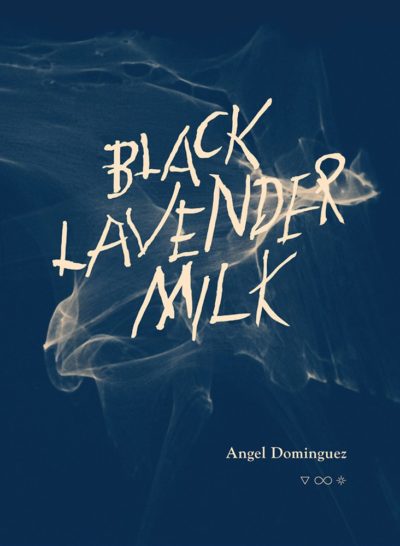 Angel Dominguez Black Lavender Milk
Angel Dominguez Black Lavender Milk
Timeless, Infinite Light
‘Black Lavender Milk is an experimental lyric that dreamt of becoming a novel only to wake up as notebook. Employing and smudging elements of poetry, prose and memoir, Black Lavender Milk offers the space of a “novel” as a site of mourning, inquiry and recuperation. Through a complex, hypnotic blur of language, the lyric-as-novel functions as an extended meditation on Writing in relation to the Body; Time, Loss, Ancestry and Dreaming.’ — T,IL
‘Paranormal poetics never sounded more redundant, more welcome and welcoming. Angel Dominguez writes, “I occupy a continent within my body. / I am going there today to bury my grandfather.” He has a continent in his body of the most extraordinary poetry turning the dream over to the soil and water of the dreamer. From orchard to ocean his omnipresent tenderness maps our way to the poet as shaman. I shudder with disbelief at his words and want them to knock on all our closed doors. There’s a home in this book like strategy where we meet to stop the hemorrhaging loss. Please read it NOW!’ — CA Conrad
_____
Excerpts
Xix: you were a watchmaker with a jewelry store in downtown L.A.; a dealer in time, you tuned quartzite: 32,768 Hz and whistled for me to follow through the subway. A bag of avocados and lemons, 3 oranges kept us quiet while waiting to arrive. I’ve kept every departure: they occupy a small wooden box below blue jars. I want(ed) you to know how I’ve roamed in search of stones, in search of other portals, in hopes of finding you somewhere with(in) a dream; I’m always trying to blur reality, nodding off into the person next to me, running into me running into me running into 4am instability. Breaking into an airport; running for the orchard. I remember things that are (not) happening, say, continuing from where we left off: soft syllables made of mud; water witching up a spell for something like transport, something like continent, something like crystal-memory; I press a tip of quartz to my tongue and run west up mountain, far from the ocean; I still smell salt when there’s a hint of blood—I bit my tongue—caught managing a mongrel timeframe not fit for linearity: somnambulism(s) last(ing) a flock of years; here I find myself failing to write an “orchard,” attempting instead: a continent within a dim body, not yet formed and tired from running:
*
Some notes on forming dzonots:
Step 1: locate the event boundary; rub the soil into your
skin. Begin digging.
Step 2: ________________________________
Step 2a: make black water: the water my grandfather described to me the morning after he had a vision: milky black midnight, thick; something that smells of salt and blood. His vision was standing on a narrow alabaster bridge in a dark space—no moon—bodies everywhere in the
water. I wonder if I too was a body in the void of dream. He didn’t know how to help them; the next day there were reports of a tsunami somewhere on the other side of the pacific. We watered the avocados and lemons. We buried salt beneath the orange tree.
Step 3: stop when you reach your elbow, or shoulder; you’ll know when to stop.
Step 4: equip the hole with a plastic bag membrane: this is not biodegradable and perhaps reminds you of an ocean or airport.
Step 4a: continue to make black water: crush charcoal
from burnt palm trees, add cold coffee and day old wine. Stir. Continue, adding salt to the liquid—watch for colloidal materials to form a constellation. Add lemon juice for avor. When the water thickens with memory, begin to pour.
Step 5: deposit what you remember losing; lower your fingers into the water and retain: rough, yet soft. Hands.
Step 6: go for a run. Continue until you reach a body of water, or become a body of water.
Step 7: return home via aeroplane. Take notes:
A room full of atoms beckons a body across the void; voice a portal with an outline—find the route that requires the least oxygen—language cryogen: Xix, I brought you a pint of old blood under the orange tree, drunk off whiskey and trying to bury notebooks behind me in a time that precedes and haunts me; I want memories to bring (me) back
Language cryogen: find an earth scab; catch a bit a glass from the nearest car crash, press the substance to skin; hints of then, buried in our blood.
Buried in our blood: a body of night, curved across a planet.
Our molecules call across the void and bury sunlight in our sleep; how will I know to meet you when I arrive?
Black Lavender Milk by Angel Dominguez Media Statement 1
Other Dzonots / Other Orchards
____________
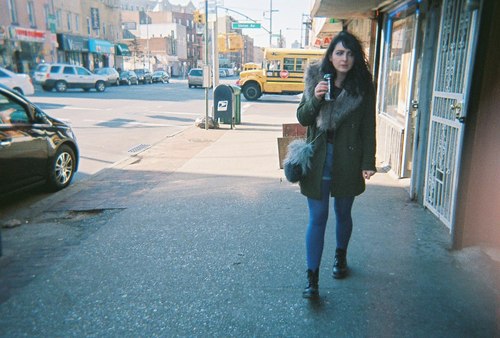
This is the story of how I got to publish Lucy K Shaw’s first book, The Motion. Besides editing Real Pants, I run a small press called 421 Atlanta. The Motion [was] released on March 31. … You can [order] it now and I suggest that you do.
Here’s how it all happened. The story is a list, in honor of the stories in The Motion that are told in list form.
1. I met Lucy K Shaw at a bar on a July night in Baltimore. We played cards, and I ate a bad oyster.
2. This was at the end of a short impromptu trip I took to visit Adam Robinson. Nothing was settled between us yet, but we were hopeful.
3. I got sick every time I ate oysters for the next 18 months.
4. In September, I talked to Adam about starting a small press named after my street address in Atlanta, 421. We were in line at a Chipotle in Baltimore. Things between us were more settled, and we were still hopeful. I would need Adam’s help to start a press.
5. By January, I had published two chapbooks, my own and Daniel Beauregard‘s. Adam designed the covers and the insides. I had asked Mary Ruefle and Maggie Nelson for manuscripts, but they both politely declined. To figure out what to publish next, I held a short prose chapbook contest, judged by Mary Miller. We got 78 entries or something, and I picked 10 or 11 finalists.
6. Adam processed the entries so that I could read them without looking at who wrote them, but I knew or strongly thought that one of the finalists was Lucy K Shaw, based on her mention of a friend named Gabby and these lines: “I had just learned where the phrase, ‘What would you do for a Klondike bar?’ comes from. An instance which had reminded me, cruelly I felt, that I hadn’t grown up in America like the rest of my friends.”
7. At that time, the manuscript was called, Pain Always Produces Logic, Which Is Very Bad For You. It had 6 stories. I knew I wanted to publish it whether or not Mary chose it as the winner. Mary chose The Passion of Joan of Arc by William Todd Seabrook, who turned out to be an experienced winner of chapbook contests. It was great fun to publish Todd’s manuscript. We had two release parties, one with Natalie Lyalin and Seth Landman, and one with Laird Hunt.
8. In the meantime, I confirmed that Lucy wrote what I suspected she wrote, and I asked to publish the manuscript later that year. Because of the time difference between Atlanta and England, the email timestamp shows that she said yes 4 hours and 9 minutes before I asked. There’s no way to know what really happened.
9. By the time we announced in April, the manuscript didn’t have a title anymore. We planned to publish the chapbook in November.
10. That didn’t happen. But we were working on it. Lucy revised and added a story, and I sent editorial notes, and by November, the manuscript had a title—The Motion, a cover image, and 7 stories. The Frank O’Hara quotation that original title came from had become an epigraph. Six months before, Adam had moved to the house that I named the press after, and we’d made plans to start this website.
11. We launched Real Pants on January 1. On January 3, I ate oysters and didn’t get sick. We had oysters again at our launch party and I still didn’t get sick.
12. All that was involved with starting the website afforded me little time to devote to The Motion. I wanted to give Lucy’s manuscript the serious attention it deserved.
13. We got back to work when the time was right. Lucy had written two more stories in the process of moving to Berlin. I continue to be astonished by how Lucy works. The last story in the book, “Wedding,” is extraordinary. (There is a tenth piece after Wedding but it isn’t a story).
14. I didn’t know it yet, but “Wedding” took The Motion from chapbook to perfect-bound book with a spine.
15. We did a quick back-and-forth with edits and sent the manuscript to the 421 Atlanta design department (Adam). He laid it out as a chapbook but asked what I thought about publishing it as a small book instead.
16. With some trepidation, I asked Lucy what she thought. I loved the idea, but what if Lucy didn’t want The Motion to be her first straight-up book book, with an ISBN and an Amazon listing and all that? What if she didn’t want her first book to come out from 421 Atlanta? The press is very small and new, with no budget to speak of, and I didn’t want to assume that just because she entrusted her chapbook manuscript to me, that she would be okay with this bait-and-switch.
17. Plus, formatted as a small perfect-bound book, The Motion is 78 pages, which is a lot fewer than most full-length books of short stories. It is the length of a full-length poetry book, maybe, but The Motion is prose.
18. I phrased my email to Lucy more like a statement than a question, to inspire confidence and trust. I called it “a short collection of prose. A short book of short stories.” It worked. She reacted like this.
19. We decided to publish a first edition of 500.
20. It’s definitely the right way. A chapbook is a singular thing of its own. Chapbooks love to be read all at once, and they don’t love to be reprinted in new editions. They come in all different shapes and bindings, sometimes sewn and sometimes stapled, but I don’t think they ever have spines. They are invertebrates. I believe in the form, and 421 Atlanta will publish chapbooks again in the future.
21. A book is an elastic, expansive, enduring thing. A book, long or short, has bones and multiple systems within it.
22. The Motion is a book. It is Lucy K Shaw’s debut collection of stories and it will be published by 421 Atlanta.
23. It’s really an honor.
— Amy McDaniel, Real Pants
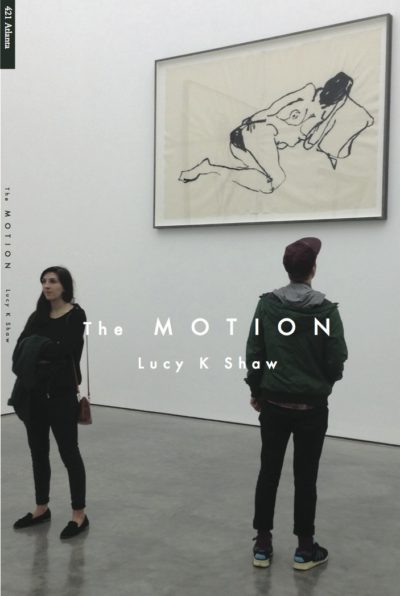 Lucy K Shaw The Motion
Lucy K Shaw The Motion
421Atlanta
‘If my first book, The Motion, was being made into a movie, it would be very expensive to make. It is set in five different countries. There are scenes at The British Museum, at Sylvia Plath’s house, in Central Park, in Brooklyn, in Queens, at an office building close to Toronto airport, in an apartment in the center of Paris, and outside of a courthouse in the suburbs of Berlin, to name just a few of the locations. If my book was being made into a movie, I would want for it to be directed by Meggie Green.’ — Lucy K Shaw
Excerpt
I Like to be in the Sea for That Reason, I Think
1. Five years ago, on my 22nd birthday, a friend sent me ‘The Easter Parade’ by Richard Yates in the mail. I had read his two short story collections, ‘Liars in Love’ and ‘Eleven Kinds of Loneliness’ two summers previously, but she didn’t know this, I don’t think. She had just read a lot of American fiction and had a good sense for what I might like too.
2. Those are the best titles though.
3. Liars in Love
4. Eleven Kinds of Loneliness
5. I have always been, I feel, the worse friend in that particular friendship. So many of my emails started, ‘I’m sorry it took me so long to respond,’ that eventually, I just stopped responding altogether.
6. Gabby recently read ‘The Easter Parade’ and we talked at length one time about how the main character, Emily Grimes, is basically just Richard Yates, as a woman. Gabby had read an interview in which Richard Yates said something like, ‘Emily fucking Grimes, that’s me.’
7. Whenever we have a conversation about writing characters who are very similar to ourselves, Gabby quotes, ‘Emily fucking Grimes, that’s me’ and I laugh and I say, ‘Yeah. Well, yeah, exactly.’
8. Emily Fucking Grimes, that’s me.
9. There’s a section in ‘The Easter Parade’ where Emily Fucking Grimes goes to live in Iowa with a bad poet who takes himself too seriously. I don’t remember too much about that part of the book except it seemed quite good at first and then soon enough, she was miserable. Also I can recall, vaguely, the layout of the house they lived in.
10. If Gabby and I went to live in Iowa, we wouldn’t write books about ourselves thinly-veiled as male characters.
11. I feel at my best when I can see very far in every direction.
12. The first line of ‘The Easter Parade’ is, ‘Neither of the Grimes sisters would have a happy life.’ The first line.
13. We have resolved, like most sensible people, to read more books actually written by women.
Trailer
‘after you’ve gone’ – cover by lk shaw
____________________
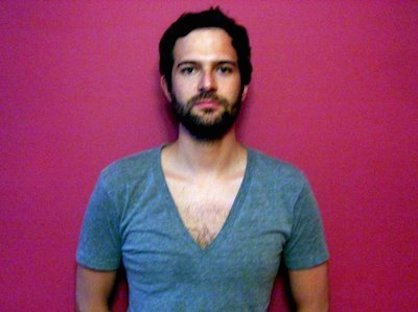
Q: I was telling someone the boiled-down set-up for Crystal Eaters – a village believes in crystal count: that every person contains within themselves a number of crystals that designate how long they have to live, and once they reach a zero-count they die; so a young girl named Remy, in an effort to save her sick mother, sets out to discover a way to increase one’s crystal count – and the thought occurred to me that the premise sounds somewhat like a videogame. Many games that I remember playing – Myst, Zelda – have a fable-like quality to them. Have videogames influenced you at all?
Shane Jones: I think videogames from my childhood influenced me a lot and while writing Crystal Eaters I remember looking at images from a bunch of games like Zelda, Super Mario Bros, and Myst. I think the fable-like quality you mentioned probably comes more from reading fables early on, or just some hardwired thing inside me that leans toward alternative realities, or hating on reality. But some of the images in games like Zelda and Super Mario Bros I really love, I think they are just beautiful pieces of art, and I’m sure they burned into my brain early on. Sega had a game called Alex Kid In Miracle World which was basically a more fucked up Super Mario Bros, more raw and poorly developed and just weird, and I played that game religiously. And a lot of those old school Sega and Nintendo games have main characters with health points or HP and I just love that. The idea of a number you have and you’re losing the number and always trying to increase it to avoid death. That’s a detail from videogames that influenced this book. I will say I don’t play videogames now. The last system I owned was the original Playstation. And here’s a confession: I never owned a Nintendo as a kid. I’m not sure I’ve ever told anyone that. I went to a friend’s house whose Dad was a heroin addict and we’d play Nintendo all day and cook hot dogs in a fire pit in the woods. For some reason, I only had a Sega. I was the weird kid playing Alex Kid In Miracle World. You should look that game up if you don’t know it. If I remember right, at the end of each stage you had to play rock, papers, scissors, to defeat a boss, which seems really lazy on the developers side and just strange. This is after you spend the entire stage punching things and avoiding skulls.
Q: Crystal Eaters contains this incredible line: “As a child what you see is creation. As an adult what you see is destruction.” What do you see?
SJ: If I talk to people or read the news I see a lot of destruction. Adults tend to talk about everything that is wrong with the world. Tell a coworker the weather for tomorrow and they’ll probably say what’s wrong with it. But if I just keep to myself and my family and, I don’t know, just walk around and be inside my own head, I see a lot of creation and beauty. The books I read and the books I write are a reflection of destruction and that reflection leads to creation. It’s a cycle, right? The line from the book you mentioned singles out Remy and her father and how the two see the world differently, which creates tension in regards to the dying mother. Sometimes adulthood feels like a trap because the responsibilities, the mundane nature of work and shopping and eating every day, can wear on you and I think that can feel like destruction. That can feel like you’re moving through mud. But not kids, no way. They are constantly in forward motion, always discovering, always creating, and I try and tell myself that often when writing: be a kid and play, don’t be an adult and complain it’s been cloudy for three days.
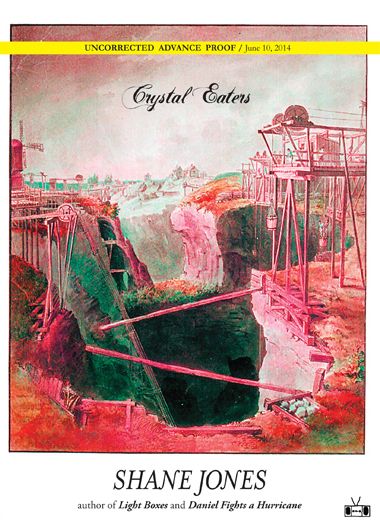 Shane Jones Crystal Eaters
Shane Jones Crystal Eaters
Two Dollar Radio
‘A grounded epiphany of the highest order, revealing the stark and majestic grace that is present within the loss each living thing must endure. Page after page, Jones’s exquisitely styled prose drugs the ear like otherworldly music—this pyretic, hallucinatory novel stings with beauty at every turn.’ — Alissa Nutting
‘Remy is a young girl who lives in a town that believes in crystal count: that you are born with one-hundred crystals inside and throughout your life, through accidents and illness, your count is depleted until you reach zero.
‘As a city encroaches daily on the village, threatening their antiquated life, and the Earth grows warmer, Remy sets out to accomplish something no one else has: to increase her sick mother’s crystal count.
‘An allegory, fable, touching family saga and poetic sci-fi adventure, Shane Jones underlines his reputation as an inspired and unique visionary.’ — Two Dollar Radio
Excerpt
The sky is laced with turquoise worms, and where the sun normally is there’s two red lips, a parting mouth with clouds for teeth. Remy’s bed contains 24 stacked pillows that form a wall. She gets into bed and looks up at the black crystal drawn on the ceiling. She closes her eyes, steadies her breathing, and touches the pillows. The mouth in the sky fills with red and the teeth vanish and it’s the sun. The worms wail and turquoise cascades down an arc in the sky.
The first pillow Remy places on her feet. The next, her legs. The next, her stomach. Finally, her chest. She builds layers until she has to balance the pillows on her body with her breathing. She puts the last three pillows on her head and hugs her face until she passes out. Her arms flop off the sides of the bed and her fingertips dangle near the floor.
She’s a baby. She takes wide, unsteady steps, and on a few occasions, tips backward, arms extended as her diaper thumps the floor. She wears a blue shirt with a hand-drawn black crystal (Brother). Her face is blond hair. She stumbles from her bedroom and into the hallway where she falls down the stairs, blond hair blown open and her body awkwardly sliding down the stairs as Mom shouts from below. Afterward, Remy cried for fourteen hours. Mom stayed awake the entire time, tapping her back in sets of ten, feeding her sips of tea, telling her it would be okay, they will come back on again.
Remy twitches in the wobbly picture and her eyelids flicker. Her arm as baby arm snaps like a bird’s spine beneath a boot. The pillows fall. One hits her arm. Mom moans from her bedroom. Her negative weight floats upward from her refusal of food. Her falling numbers hurt everything around her, even the carpet looks depressed. Dad skips between loving companion to distant husband to angry father. He spends his days alone. Each day this week he’s been sitting gargoyle-perched on the roof. Recently, Remy thought the problem of Mom’s sickness isn’t Mom’s sickness exactly, but Dad’s reaction to Mom’s sickness.
Remy writes in a notebook:
FELL DOWNSTAIRS AS A BABY -5 CRYSTALS.
SUBTRACT -1 FOR EVERY YEAR AFTER FROM AGING.
She puts three pillows on her face and grips tight until she passes out again, her hands falling off the bed, eyes now moving over a dark road. She’s riding her bike with the blue and yellow tassels tied to the handlebar. She wanted red and green, to be special, but Dad bought the commons. This vision like the last is broken from reality but more severe – Remy riding her bike on the road to the mine, blue and yellow tassels blowing endlessly backward and touching her home. Her hair is also endlessly long and it touches the house. She’s followed by a spotlight. Her feet blur on the pedals. She’s trying to escape the light. Skin three inches above her right ankle catches on the rear derailleur and the bike breaks into a severe slide. Water sprays from where the tires skid. The road becomes a beach and Brother is standing there covered in glistening sweat, jogging in place, with Harvak at his side who is also jogging in place. Sea crystals the shape of hexagons colored white foam then harden to black stone on the sand. An octopus is flung by the sun across the sky. The spotlight disappears and the man, who looks just like Dad, who held the spotlight, twirls his hand goodbye, bows, then jumps off the cliff at the top of The Bend.
Shane Jones reading from ‘Light Boxes’
Trailer: Shane Jones ‘Daniel Fights A Hurricane’
*
p.s. Hey. ** Ferdinand, Thanks, man. Hope things are spotless. ** _Black_Acrylic, Hi, B. Indeed! The late period is kind of hit or miss IMO, but, yeah, every once in a while they totally nail it. ** Misanthrope, Nice that you’ll get a little break. And, obviously, great that you have Kayla as a fellow warrior. Hm, I wonder if you’ll like The Fall. Hard to predict, knowing what I know you like. But you might, yeah. He was a helluva wordsmith for one thing. ** David Ehrenstein, Thank you! ** Sypha, I’d recommend starting with ‘This Nation’s Saving Grace’ or ‘The Frenz Experiment’. Good about Golem. As I’ve probably mentioned, I fucking hate bosses. I usually beg someone I know to beat the bosses for me so I can keep going. ** Dominik, Hi!!!! Awesome that you’re a Fall fan. ‘The Undead’ wasn’t our best piece, mostly because we collaborated on it with this theater director who had boring ideas that we were constantly fighting with. But parts are really good. We’ve talked about doing a drastic remake of it, but I don’t think we ever will. Thanks about it! Gisele has an amazing balljoint doll she brought back from Japan. Next time I get down there I’m definitely going to hit the shops that feature them. I’ve heard so much about Édouard Louis, but I’ve strangely not read him yet. People I know in the US seem really into his stuff. My friends here in France are more mixed about it. Are you reading him? What do you think, if so? Ha ha. Are there still TED talks? I guess there must be. Love as an inflatable sex doll listening to some boring guy wearing a Love Halloween costume drone on and on about his marriage while slowly deflating and making fart noises, G. ** Steve Erickson, Ah, you started with ‘Hey Luciani!’. What a great single. I haven’t read Brix’s memoir, no, but I want to and keep forgetting to score it. I love the Brix era of The Fall. The book’s good, huh? Okay, I’ll write a reminder on my hand with an ink pen like we used to do in the old days. That seems right about the feasibility of horror movies over or dramas, although I guess if ‘Nomadland’ wins Best Picture that might change? Probably not. RIP Bertrand Tavernier, yes. Wonderful director. He got in some hot water here in France for weirdly supporting Sarkozy for President several years ago, but I think all was eventually forgiven. ** Jeff J, Thanks, Jeff. I never saw ‘I Am Kurious Oranj’, unfortunately, no. The album is great. I did see the Michael Clark company a couple times when their pieces had Fall soundtracks, but it was pre-recorded. Haven’t read the Mark E. Smith autobiography, and I have no idea why, really. Mostly just because I’m so much more geared to read fiction for whatever reason, I guess. Was surprised (and delighted) to find so much of Belson’s stuff online, especially since he forbade that, oops. ‘Utz’ is the Chatwin I’ve always been drawn towards but haven’t yet read. Maybe I’ll try that one. I’m not involved in the day to day editing of the ‘Jerk’ film, but, for instance, I’m going to spend most of today in the editing room giving my thoughts on what Gisele and have done so far. I’ll probably do that again once or twice before it’s finished. The whole film is a single shot — well, with two cheats — so the editing is a different kind of process, mostly picking the best three takes to mush together. Great luck and sanitised hugs to Stephanie, and, of course, to you, maestro. ** Jack Skelley, (1) Thank you, as do you (have good taste) apparently since you wrote that, ha ha. (2) No way, Lawndale played with The Fall!!! And at the I Beam! That is some unbelievably seriously coolness right there. Wow. *bowing* (3) That would be nice, yes. A totally wired weekend. Would that even be technically possible under these circumstances? Maybe. Never say never. Totally weird might be more likely. You, however, are in a much better position to have a totally wired weekend, so, no excuses, have one! ** Okay. I decided to do a books/loved post but about books I read a little while ago, for instance those five jewels up above that were published around five, six years ago and were well received at the time but which I don’t feel people are talking about very much these days. And they should be talked about, in a nutshell. So I recommend that you read them, n’est pas? See you tomorrow.
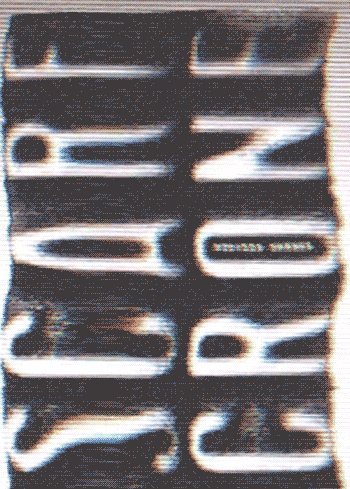




 Now available in North America
Now available in North America 
I read the Lucy K Shaw last year and really loved it. Fully deserving of its props here today!
Yesterday I received this unexpected gift in the post from the folk at Tak Tent Radio, Harry Sword – Monolithic Undertow: In Search of Sonic Oblivion, a history of drone music from neolithic times to doom metal and transcendental bass sounds. Just started last night and enjoying it a great deal already.
Books I’ve read in the recent past and still love:
“Within the contxt of No Context” by George W.S. row
“The Smithsonian Institution” by Gore Vidal
“Christopher and his kins” by Christopher Isherwood
“Mostly About Linday Anderson” by Gavin Lambert
“The Marbled Swarm” by Denns Cooper
“A Frolic of His Own” by William Gaddis
“The Arcas Project” by Walter Benjamin
I’m still reading a lot of older Gothic fiction (currently reading William Beckford’s VATHEK, from 1786), along with blowing through some of the slimmer Snuggly Books books I’ve had lying around for awhile now.
Hi!!
Such a great post again! I haven’t read any of these books, and it looks like I’d like to, all of them. Thank you!
Oh, shit. Yet another project, then, where you had to fight other people’s mainstream ideas. But you never know, you never know! Maybe that remake will just grow out of something all naturally.
Oh my… I’m a little jealous of Gisele right now, haha. Next Sunday is my birthday, and I’m very tempted to buy myself a doll. But… I also want my self-present to be a tattoo. So we’ll see which one wins in the end, hah.
I’ve just finished Édouard Louis’ “History of Violence,” and I loved it so hard I can’t tell you. It was easily the best book I’ve read this year. It really slapped me around both with its style and content just the way I want a book to slap me around. I can only recommend him. I think he has three books in total, and I’m about to track down his other two.
Hahaha, your love made me laugh out loud; I can see it so clearly. Love slipping into a manic episode and frantically buying up every single copy of your books all across the US, Od.
I’ve enjoyed Katie Jean Shinkle and Shane Jones’ books, wonder what they’re up to these days. Will explore further.
Am rereading some Daniel Clowes comics, which hold up pretty well 10-15 years later. Also read Michael DeForge’s comic Stunt, probably the best thing I’ve read from him.
Bill